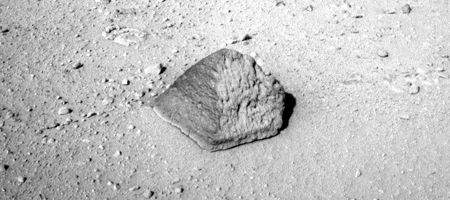NASA’s Mars rover Curiosity is taking a break from its drive to Glenelg to examine a football-size rock with its robotic arm.

In the next few days, both the arm-mounted Alpha Particle X-Ray Spectrometer and the mast-mounted, laser-zapping Chemistry and Camera Instrument will be used to identify elements in the rock, allowing a cross-check of the two instruments.
The rock – which has a surprisingly regular pyramidal shape – has been named Jake Matijevic, after the surface operations systems chief engineer for the rover, who died on August 20, aged 64.
Curiosity is now halfway to its main destination, after driving six days in a row. On each of those days, it’s covered between 72 and 121 feet.
“This robot was built to rove, and the team is really getting a good rhythm of driving day after day when that’s the priority,” says MSL project manager Richard Cook.
When the rover reaches Glenelg, it will choose another rock for drilling, with the aim of analyzing powder drilled from the interior. Glenelg was picked because three types of terrain intersect there – one lighter-toned and another more cratered than the terrain Curiosity currently is crossing.
The light-toned area is particularly intriguing, as it retains daytime heat long into the night, suggesting an unusual composition.
“As we’re getting closer to the light-toned area, we see thin, dark bands of unknown origin,” says MSL project scientist John Grotzinger of the California Institute of Technology. “The smaller-scale diversity is becoming more evident as we get closer, providing more potential targets for investigation.”
Recent images from the rover’s camera reveal dark streaks on rocks in the Glenelg area that have got the researchers rather excited.
But the camera’s also been looking up, and has recorded images of Mars’ two moons, Phobos and Deimos, passing in front of the sun.
“Phobos is in an orbit very slowly getting closer to Mars, and Deimos is in an orbit very slowly getting farther from Mars,” said Curiosity’s science team co-investigator Mark Lemmon of Texas A&M University. “These observations help us reduce uncertainty in calculations of the changes.”






